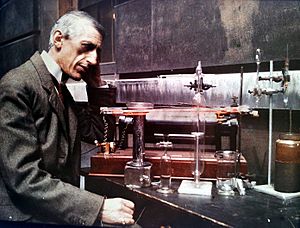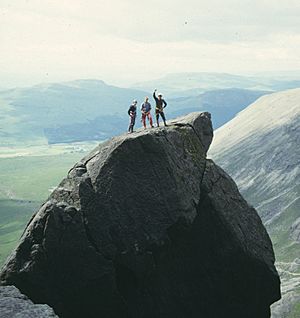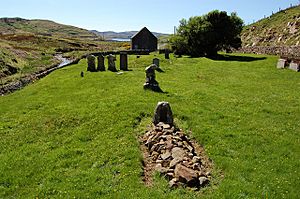J. Norman Collie facts for kids
Quick facts for kids
J. Norman Collie
FRSE, FRS
|
|
|---|---|
 |
|
| Born |
John Norman Collie
10 September 1859 Alderley Edge, Cheshire, England
|
| Died | 1 November 1942 (aged 83) Sligachan, Isle of Skye, Scotland
|
| Citizenship | British |
| Awards | Fellow of the Royal Society |
Professor John Norman Collie (born September 10, 1859 – died November 1, 1942) was an amazing English scientist, mountaineer, and explorer. He was often called J. Norman Collie. He made important discoveries in chemistry and was also a very skilled climber who explored mountains around the world.
Contents
A Young Scientist's Journey
John Norman Collie was born in Alderley Edge, England, in 1859. He was the second of four sons. When he was 11, his family moved to Clifton. He went to different schools, but in 1875, his family lost their money because of the American Civil War. This meant John had to leave his school and go to Clifton College. There, he found he really liked chemistry.
He later earned a PhD in chemistry in Germany in 1884. When he came back to Britain, he taught for three years. After that, he joined University College London (UCL) to work with William Ramsay.
Important Discoveries in Chemistry
Collie did a lot of important research. He helped with the work that led to taking the first x-ray images for doctors to use. He also worked with Ramsay on special gases called "inert gases."
In 1909, he even built the very first neon lamp! The way neon glowed when it touched mercury was sometimes called the "Collier effect." He also suggested a new way to think about the structure of a chemical called benzene.
Collie was a professor of Organic Chemistry at UCL from 1896 to 1913. He then led the chemistry department from 1913 to 1928. He was recognized for his work and became a member of the Royal Society of Edinburgh in 1888 and the Fellow of the Royal Society in 1896.
Amazing Mountain Adventures
Even though Collie was a scientist, his real passion was climbing mountains. He is famous among climbers for his amazing first ascents on the Cuillin mountains in the Isle of Skye, Scotland. He also climbed in the English Lake District and the Alps.
Exploring the Cuillin Hills
Collie started climbing in Skye around 1886. He first went there to fish but ended up climbing a mountain called Sgùrr nan Gillean. He met John Mackenzie, a local guide from Skye. They became great friends and climbed many mountains together for the first time.
In 1899, Collie discovered a unique rock feature called the Cioch. He climbed it with MacKenzie in 1906. Collie also helped create much better maps of the Cuillin mountains, which were very hard to map before. Today, a peak called Sgúrr Thormaid (which means Norman's Peak) is named after him. There's also a famous climbing route called Collie's Ledge on Sgùrr Mhic Choinnich, named after his friend MacKenzie.
Collie also made important climbs on mainland Scotland. He was part of the first team to climb Tower Ridge on Ben Nevis in winter in 1894.
Adventures in the Himalayas and Canadian Rockies
In 1895, Collie, along with other climbers, went to the Himalaya mountains. They tried to climb Nanga Parbat, one of the world's highest peaks. This was a very early attempt at such a high mountain. Sadly, one of his climbing partners and two local guides were lost in an avalanche. Collie wrote a book about this difficult trip called From the Himalaya to Skye.
After climbing in the Alps, Caucasus, and Himalayas, Collie went to the Canadian Rockies in 1897. From 1898 to 1911, he visited the Canadian Rockies five more times. He made 21 first ascents (meaning he was the first person to climb them) and named over 30 peaks! He was especially interested in finding and climbing two legendary mountains, Hooker and Brown, which were thought to be very tall. In 1903, Collie and Hugh Stutfield wrote an important book about the region called Climbs and Explorations in the Canadian Rockies.
Later Life and Legacy
Collie retired in 1929 and spent his summers in Skye. He passed away in November 1942 from pneumonia. He had fallen into a loch (a lake) while fishing the year before. As he wished, he was buried next to his good friend, John MacKenzie, in an old graveyard in Skye.
An Inspiration for Sherlock Holmes?
Some people think that Norman Collie might have inspired parts of the famous detective Sherlock Holmes, created by Arthur Conan Doyle. Collie was a bachelor who shared his house with a lawyer, just like Holmes. He had a very analytical mind from his chemistry research and enjoyed many hobbies, from Chinese porcelain to fishing. He was also known for smoking his pipe a lot, much like Holmes!
Honours and Recognitions
- Fellow of the Royal Society (1896)
- Fellow of the Royal Geographical Society (1897)
- President of the Alpine Club (1920–1922)
- Member of the Mount Everest Committee (1921)
- Mount Collie in Yoho National Park and Sgurr Thormaid (Norman's Peak) on the Isle of Skye were both named after him.
Memorial
A special project worked for ten years to raise money for a bronze statue and memorial for John MacKenzie and Norman Collie on Skye. The statue was designed by local artist Stephen Tinney. It was unveiled in September 2020 near the Sligachan Hotel, looking out over the beautiful Cuillin Hills.






